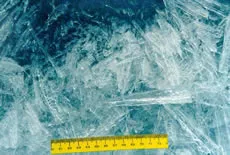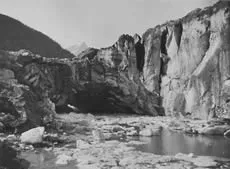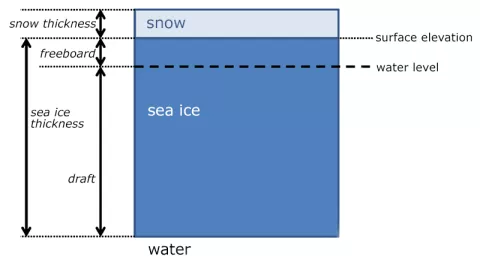Cryosphere glossary
separate patch of floating ice or flat sheet of unbroken pack ice, greater than 20 meters (22 yards) across.
ice that is pushed into the underlying ocean water by the weight of thick snow cover on its surface; the salty ocean water floods the snow cover and creates a salty, slushy layer; flooded sea ice is more common in the antarctic because of more snowfall and thinner sea ice than in the arctic.
Image

Ted Maksym, Unites States Naval Academy
a small percolation channel that is a beginning path for surface meltwater through snow or firn.
a line following the spatial pattern of glacier movement from the top to the terminus. Englacial and supraglacial moraines make some glacier flowlines discernible from the surface.
an iceberg that is grooved into a curtain-like pattern; thought to be carved by small meltwater streams.
a hydrometeor consisting of a visible aggregate of minute water droplets (or ice crystals), suspended in the atmosphere near the earth's surface; according to international definition, fog reduces visibility below one kilometer, fog differs from cloud only in that the base of fog is at the earth's surface while clouds are above the surface; when composed of ice crystals, it is termed ice fog.
layering in glacier ice that has distinctive crystal sizes and/or bubbles; foliation is usually caused by stress and deformation that a glacier experiences as it flows over complex terrain, but can also originate as a sedimentary feature.
alternate bands of light and dark on a glacier; usually found below steep narrow icefalls and thought to be the result of different flow and ablation rates between summer and winter.
structure used when the soil near the ground surface is not strong and the weight of the building must be carried by deeper soil layers.
a distinct soil micromorphology, resulting from the effects of freezing and thawing processes, in which soil particles form discrete units that are densely packed.
a distinct soil micromorphology, resulting from the effects of freezing and thawing processes, in which soil particles form discrete units that are coalescing.
a sea channel connecting the Arctic Ocean and the Nordic Seas, running between Greenland and Spitsbergen. Fram Strait is the passageway where most drifting sea ice exits the Arctic.
small needle-like ice crystals, typically 3 to 4 millimeters in diameter, suspended in water, that represent the first stages of sea ice growth; they merge under calm conditions to form thin sheets of ice on the surface, frazil crystals consist of nearly pure fresh water.
Image

Frazil crystals.
Don Perovich, U.S. Army Cold Regions Research and Engineering Laboratory
fine spicules or plates of ice in suspension in water.
Image

Frazil crystals.
Don Perovich, U.S. Army Cold Regions Research and Engineering Laboratory
free water is that portion of the pore water that is free to move between interconnected pores under the influence of gravity.
Image

Free water at the base of Dirt Glacier, British Columbia, in 1904.
C.W. Wright, archived at the World Data Center for Glaciology, Boulder, CO
the thickness of sea ice protruding above the water level. Freeboard and draft comprise total sea ice thickness.
Image

Freeboard and draft comprise sea ice thickness.
Walt Meier